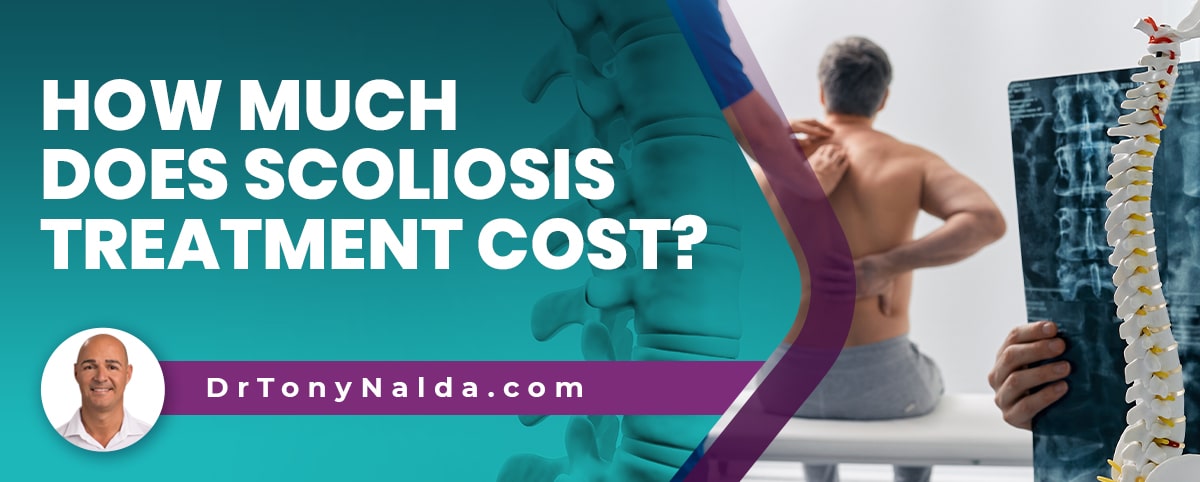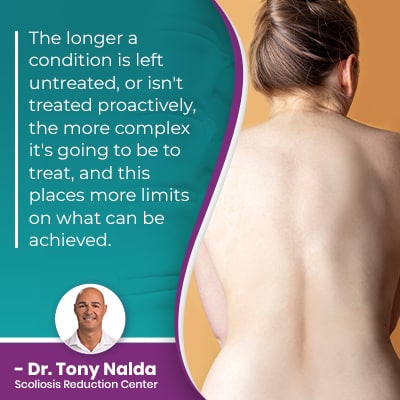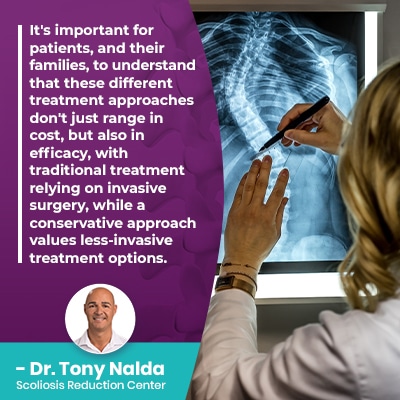How Much Does Scoliosis Treatment Cost? [ANSWERS]

As no two cases of scoliosis are the same, the cost of scoliosis treatment is equally wide-ranging. There are a number of variables that factor into the cost of treatment such as condition type, severity, patient response, and the type of treatment chosen. Continue reading to learn more about the different treatment approaches and costs associated with each.
There is no flat fee for scoliosis treatment; different conditions and treatment approaches will range widely in cost. In addition, there is more than just the monetary cost of scoliosis treatment to consider as treatment results can impact overall quality of life.
Before exploring the different types of treatment and treatment costs, I'd like to first discuss the cost of leaving a condition untreated, a choice that can have far-reaching effects.
Table of Contents
The Importance of Scoliosis Treatment
If someone is diagnosed with scoliosis, it means they have developed an unnatural sideways spinal curve, but in addition to the spine curving unnaturally to the side, it also rotates, making it a complex 3-dimensional condition.
Scoliosis is a progressive condition, meaning it's incurable, but can be highly treatable, depending on how a diagnosis is responded to with treatment.
Scoliosis being progressive means that its nature is to get worse over time, and the condition's severity levels reflect its progressive line: mild scoliosis, moderate scoliosis, severe and very severe scoliosis.
So even scoliosis diagnosed as mild doesn't mean that's where it will stay; only proactive treatment can work towards counteracting the condition's progressive nature.
While there are never treatment guarantees, early detection and intervention does come with a number of benefits that increase the likelihood of treatment success, and it's not always easy to catch scoliosis early.
If scoliosis is progressing, it means the size of the scoliotic curve is increasing, as are the condition's uneven forces, and their effects.
 The longer a condition is left untreated, or isn't treated proactively, the more complex it's going to be to treat, and this places more limits on what can be achieved.
The longer a condition is left untreated, or isn't treated proactively, the more complex it's going to be to treat, and this places more limits on what can be achieved.
As a scoliotic curve increases in size, it's becoming more rigid, making it less responsive to treatment, and scoliosis doesn't just affect the spine, but also its surrounding muscles and nerves.
So there is a high cost of not treating scoliosis: leaving it to progress unimpeded, making it more complex to treat, and its symptoms more severe.
It's far simpler to address scoliosis proactively while mild, by working towards preventing complications and escalating symptoms, rather than working to try and reverse them once they've developed.
Now that we've defined the condition and touched on the importance of treatment, let's talk about the different types of scoliosis, determined by causation.
Different Types of Scoliosis
Not only does scoliosis range so widely in severity from mild to moderate and severe to very severe, there are also multiple different types a person can develop.
The most common type of scoliosis to affect both children and adults is idiopathic scoliosis, and the idiopathic designation means not clearly associated with a single-known cause.
Adolescent idiopathic scoliosis is the most prevalent condition-type overall, and this is diagnosed in adolescents between the ages of 10 and 18.
Idiopathic scoliosis accounts for approximately 80 percent of known diagnosed cases, and the remaining 20 percent are associated with known causes: neuromuscular scoliosis, degenerative scoliosis, and congenital scoliosis.
While we don't know why the majority of idiopathic scoliosis cases develop initially, we do know what triggers them to progress, and that's growth and development, so adolescent idiopathic scoliosis patients are at risk for rapid-phase progression due to the rapid and unpredictable growth spurts that define the state of puberty.
So as you can see, scoliosis involves many factors that make each case unique; scoliosis affects all ages, can develop in any section of the spine, ranges widely in severity, has multiple types that can develop, and these variables shape the final cost of scoliosis treatment.
Now, depending on the treatment approach chosen, progression is managed differently.
Scoliosis Treatment Approaches
There are two main scoliosis treatment options: a traditional approach and conservative treatment.
The traditional approach will recommend watching and waiting in mild cases, and this means simply observing a condition for signs of continued progression, but as a progressive condition, virtually all scoliosis patients are going to experience progression at some point.
Traditional treatment includes observation, traditional bracing, such as the boston brace that's associated with a number of shortfalls, and spinal fusion surgery.
Just as all surgical procedures come with their share of risks and potential side effects and complications, spinal fusion surgery is no exception.
Spinal fusion involves fusing the curve's most-tilted vertebrae into one solid bone, and then rods are commonly attached to the spine with pedicle screws to hold the spine in place, and this hardware is permanent.
Once a spine is fused, it's fused for life, and if there are any post surgical complications such as a hardware malfunction, or an adverse reaction to the hardware, the only recourse is revision surgeries.
Spinal fusion is an invasive procedure, and when it comes to scoliosis surgery costs, there is also the long term costs to quality of life to consider; spinal fusion makes the spine more vulnerable to injury, sometimes limiting activities, and in many cases, there is a significant loss of spinal flexibility and range of motion that can impact overall quality of life.
Conservative Treatment
Here at the Scoliosis Reduction Center, I treat patients with conservative treatment, and one of the primary goals of conservative treatment is to help patients avoid surgery.
As surgery can come at the cost of the spine's natural strength and function, I want to address a patient's condition in a way that preserves as much of the spine's natural strength and function as possible.
In addition, I respond to a mild scoliosis diagnosis, and any severity level for that matter, with starting treatment as soon as possible, when there are fewer limits to what can be achieved.
Conservative treatment integrates multiple treatment disciplines so conditions are impacted on every level from condition-specific chiropractic care to physical therapy, corrective bracing, and rehabilitation.
As a structural spinal condition, I want to primarily impact scoliosis on a structural level by reducing the size of the unnatural spinal curvature, and this involves a series of chiropractic techniques and manual adjustments with potential to reposition the most-tilted vertebrae back into alignment with the rest of the spine.
As scoliosis also affects the spine's surrounding muscles, and the spine relies on support from those muscles, physical therapy is used to increase core strength so the spine is optimally supported and stabilized.
Ultra corrective braces can help augment corrective results by pushing the spine into a corrective position, known to be particularly effective on growing spines.
For long-term sustainable treatment results, rehabilitation involves a series of custom-prescribed exercises to help patients establish a home-rehabilitation program.
The Financial Cost of Scoliosis Treatment
When it comes to comparing costs of the different types of treatment, the costs below are associated with the different levels/types of care, but keep in mind that these are just estimates and many factors can change the total cost of scoliosis treatment.
Costs associated with traditional treatment include:
- $1,000s for a brief surgical consultation
- Traditional bracing (associated with shortfalls) ranging between $2,500 and $2,600
- Spinal fusion surgery can cost anywhere from $80,000 to $175,000
An important thing to note when looking at the costs associated with traditional treatment is that physical therapy and rehabilitation aren't even offered, so treatment efficacy is limited as conditions aren't impacted on every level.
Costs associated with conservative treatment include:
- $200-$300 for a comprehensive consultation/assessment
- Chiropractic care, in-office therapy and rehabilitation offered for $300/session (10-20 sessions are often recommended)
- Corrective bracing (not offered by traditional treatment) costs 25 to 30-percent more than traditional bracing, but has corrective potential
- Home rehabilitation and equipment costs range from $700-$1,000
 It's important for patients, and their families, to understand that these different treatment approaches don't just range in cost, but also in efficacy, with traditional treatment relying on invasive surgery, while a conservative approach values less-invasive treatment options.
It's important for patients, and their families, to understand that these different treatment approaches don't just range in cost, but also in efficacy, with traditional treatment relying on invasive surgery, while a conservative approach values less-invasive treatment options.
Conclusion
When it comes to comparing costs of scoliosis treatment, there are multiple costs to consider.
The cost of choosing to leave scoliosis untreated is by far the highest as this leaves conditions to progress unimpeded, making them more complex to treat, while exposing patients to the hardships associated with increasing condition severity, escalating symptoms, and the need for spine surgery in the future.
The monetary costs associated with different types of treatment are important factors to consider, but the cost to the spine's overall strength and function is what can really impact a patient's potential quality of life.
A conservative approach has the end goal of correction, while a traditional approach has the ultimate goal of stopping progression: two different things.
For those choosing to forgo a surgical recommendation, or who simply want to try a less-invasive and less-costly option first can reach out here to contact the Scoliosis Reduction Center for support and guidance.
Dr. Tony Nalda
DOCTOR OF CHIROPRACTIC
After receiving an undergraduate degree in psychology and his Doctorate of Chiropractic from Life University, Dr. Nalda settled in Celebration, Florida and proceeded to build one of Central Florida’s most successful chiropractic clinics.
His experience with patients suffering from scoliosis, and the confusion and frustration they faced, led him to seek a specialty in scoliosis care. In 2006 he completed his Intensive Care Certification from CLEAR Institute, a leading scoliosis educational and certification center.
About Dr. Tony Nalda
 Ready to explore scoliosis treatment? Contact Us Now
Ready to explore scoliosis treatment? Contact Us Now





